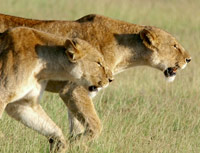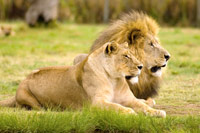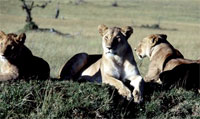
 The only social cat : Lions are predatory carnivores who live in large, social family groups, called prides. They are the only cats that live in groups, as most big cats are solitary. The family consists of related females, their cubs of both sexes, and one or more males (often brothers) who mate with the adult females. The only social cat : Lions are predatory carnivores who live in large, social family groups, called prides. They are the only cats that live in groups, as most big cats are solitary. The family consists of related females, their cubs of both sexes, and one or more males (often brothers) who mate with the adult females.
Cheek rubs: Pride members usually rub their cheeks together when they meet as a greeting. They have 6 types of vocalizations, which include growls, roars, chuffs(a friendly noise) and grunts.
 Female hunters: The females, who are lighter and more agile, do the hunting for the pride, while the male defends their territory and guards cubs while the females hunt. The females cooperate with each other, switching roles in the hunt in order to effectively kill the prey of the moment. Lion legs are relatively short but have very powerful muscles that aid it in sprinting to bring down large prey. They use their forelegs on the prey, grabbing or slapping it down. The lionessess must depend on each other for cooperation and stealth, since many of their prey can run faster than them. Lions run around 30-36 mph, whereas much of their prey can reach 50 mph! Successful stalking and camouflage from their coloring all aid in the hunting. Also they are much more successful hunting in groups than alone. Even two lionesses instead of one will the increase the rate of success significantly. Female hunters: The females, who are lighter and more agile, do the hunting for the pride, while the male defends their territory and guards cubs while the females hunt. The females cooperate with each other, switching roles in the hunt in order to effectively kill the prey of the moment. Lion legs are relatively short but have very powerful muscles that aid it in sprinting to bring down large prey. They use their forelegs on the prey, grabbing or slapping it down. The lionessess must depend on each other for cooperation and stealth, since many of their prey can run faster than them. Lions run around 30-36 mph, whereas much of their prey can reach 50 mph! Successful stalking and camouflage from their coloring all aid in the hunting. Also they are much more successful hunting in groups than alone. Even two lionesses instead of one will the increase the rate of success significantly.
 Gorge then sleep: Lions hunt many animals, including antelope and other hoofed animals, reptiles, baby elephants or rhinos, insects, rodents, crocodiles and even huge animals like buffalo and giraffes! They will also scavenge kill from other animals like cheetahs, leopards, and hyenas. Lions are quick digesters which allows them to eat huge meals at once, and then often return again for a second helping. Followed of course, by long periods of napping! Some zoos, to imitate their diet in the wild, will have the lions fast at least one day a week. Gorge then sleep: Lions hunt many animals, including antelope and other hoofed animals, reptiles, baby elephants or rhinos, insects, rodents, crocodiles and even huge animals like buffalo and giraffes! They will also scavenge kill from other animals like cheetahs, leopards, and hyenas. Lions are quick digesters which allows them to eat huge meals at once, and then often return again for a second helping. Followed of course, by long periods of napping! Some zoos, to imitate their diet in the wild, will have the lions fast at least one day a week.
Eyes for prey: Lions have very good night vision, equipped with a horizontal streak of cells across their eyes that helps them to follow prey across a plain.
 Defending the pride: Both males and females will defend the pride against intruders. Typically, males will not tolerate outside males, and females will not tolerate outside females. Males are expelled from the pride or leave on their own when they reach maturity. The male lion is a superb master and defender of his pride and territory. Defending the pride: Both males and females will defend the pride against intruders. Typically, males will not tolerate outside males, and females will not tolerate outside females. Males are expelled from the pride or leave on their own when they reach maturity. The male lion is a superb master and defender of his pride and territory.
Let's get physical: A big part of communication for lions has to do with body contact. As mentioned above, lions (in the same pride) will greet each other by rubbing their cheeks together. Sometimes this will also go on to a longer neck and body rubbing. Grooming is both a social and health activity - their hard tongue combs removes fleas, ticks and other parasites, as well as blood after feeding. Social bonds are strengthened through grooming as well.
It's all in the face: Lions are also very sensitive to small, seemingly unnoticeable changes in their posture to each other. Facial expressions can represent a variety of meanings, threats, greetings and can easily be accompanied by growling, snarling, hissing and other more obvious sounds.
Contagious behaviors: Researchers have noticed that with lions, activities are often contagious. If one lion starts doing something - yawn, stretch, groom, roar - often the whole group will start doing the same thing!

Lots of sleeping: Lions do a lot of resting, sleeping and taking it easy, combined with intense bursts of activity. The resting and lying around sometimes takes up to 21 hours of the day!
 Climbers: Lions are also good climbers and will sometimes go up trees for a view, to get away from flies or to catch a breeze in the heat. Climbers: Lions are also good climbers and will sometimes go up trees for a view, to get away from flies or to catch a breeze in the heat.
Attacks on humans: While a hungry lion may occasionally attack a human that passes near, some (usually male) lions seem to seek out human prey. Some of the more publicized cases include the Tsavo maneaters and the Mfuwe man-eater. In both cases the hunters who killed the lions wrote books detailing the lions' "careers" as man-eaters. In folklore, man-eating lions are sometimes considered demons.
The Mfuwe and Tsavo incidents did bear some similarities. The lions in both the incidents were all larger than normal, lacked manes and seemed to suffer from tooth decay. Some have speculated that they might belong to an unclassified species of lion, or that they may have been sick and could not have easily caught prey.
There have also been recorded attacks on humans by lions in captivity; tigers are statistically much more likely to attack humans in captivity. Wild lions are also much less likely to attack humans than wild tigers are.

Tawny colored: African lions (the predominant lion left) are usually a tawny color. There are cases of white lions, but those are rare - a white lion has a disadvantage when it comes to hunting: it can be
given away by its color, unlike the regular lion which blends in with
its surroundings. White lions are born almost pure white without the
normal camouflaging spots seen in lion cubs. Their color gradually
darkens to cream or ivory co lour (known as blonde). Lions have a large head and a sturdy, and long, deep chested body. There are cases of white lions, but those are rare - a white lion has a disadvantage when it comes to hunting: it can be
given away by its color, unlike the regular lion which blends in with
its surroundings. White lions are born almost pure white without the
normal camouflaging spots seen in lion cubs. Their color gradually
darkens to cream or ivory co lour (known as blonde). Lions have a large head and a sturdy, and long, deep chested body.

The unusual and useful mane: Lions are the only big cat that have such a distinct difference between the male and female, other than size - the mane. The mane protects the lion's necks from other lion's claws during territory fights with other males.
The maneless lion: The first lions are presumed to have been maneless. Until around 10 000 years ago, maneless forms seem to have persisted in Europe, and possibly the New World. The maned form may have appeared c. 320 000–190 000 years ago. This maned form may have had a selective advantage that enabled it to expand to replace the range of earlier maneless forms throughout Africa and western Eurasia by historic times.
 Now there are primarily only African lions. That wasn't always the case! Now there are primarily only African lions. That wasn't always the case!
Because of humans, lions were driven out of many other parts of the world. Even now, because of human use of the grasslands where lions live, the lions' range has been drastically reduced.
 Lions... kicked out: The Asiatic Lion (subspecies Panthera leo persica), which in historical times ranged from Turkey to India through Iran (Persia) and from Caucasus to Yemen, was eradicated from Palestine by the Middle Ages and from most of the rest of Asia after the arrival of readily available firearms in the 18th century. In Iran the last lion was shot in 1942. The subspecies now survives only in and around the Gir Forest of northwestern India. About 300 lions live in a 1412 km² (558 square miles) sanctuary in the state of Gujarat, which covers most of the forest. Asiatic lions are very endangered. Lions... kicked out: The Asiatic Lion (subspecies Panthera leo persica), which in historical times ranged from Turkey to India through Iran (Persia) and from Caucasus to Yemen, was eradicated from Palestine by the Middle Ages and from most of the rest of Asia after the arrival of readily available firearms in the 18th century. In Iran the last lion was shot in 1942. The subspecies now survives only in and around the Gir Forest of northwestern India. About 300 lions live in a 1412 km² (558 square miles) sanctuary in the state of Gujarat, which covers most of the forest. Asiatic lions are very endangered.
European lions: Lions had become extinct in Greece, their last European outpost, by 100. Other extinct subspecies are the Cape Lion, the European Cave Lion (subspecies Panthera leo spelaea) which coexisted with humans throughout the last Ice Age, and the American lion (subspecies Panthera leo atrox), a close relative of the European cave lion (not to be confused with the mountain lion or puma).
The major differences between lion subspecies are location, mane appearance, size and distribution. Genetic evidence suggests that all modern lions derived from one common ancestor only circa 55,000 years ago. Therefore most sub-Saharan lions could be considered a single subspecies Panthera leo leo.

 Poor cubs: To reproduce, the lions mate over long periods of time. When a new male (or a coalition) takes over a pride and ousts the previous master(s), the conquerors often kill any remaining cubs. This is explained by the fact that the females would not become fertile and receptive until the cubs grow up or die. The male lions reach maturity at about 3 years of age and are capable of taking over Poor cubs: To reproduce, the lions mate over long periods of time. When a new male (or a coalition) takes over a pride and ousts the previous master(s), the conquerors often kill any remaining cubs. This is explained by the fact that the females would not become fertile and receptive until the cubs grow up or die. The male lions reach maturity at about 3 years of age and are capable of taking over  another pride at 4-5 years old. They begin to age (and thus weaken) at around 8. This leaves a short window for their own children to be born and mature — the fathers have to procreate as soon as they take over the pride. another pride at 4-5 years old. They begin to age (and thus weaken) at around 8. This leaves a short window for their own children to be born and mature — the fathers have to procreate as soon as they take over the pride.
Sometimes a female may defend her and the ousted male's children from the new master, but such actions are rarely successful.
 Cross-breeding Lions with Other Big Cat Species: Hybrids were once commonly bred in zoos, but this is now discouraged due to the emphasis on conserving species and subspecies. Hybrids are still bred in private menageries and in zoos in China. Cross-breeding Lions with Other Big Cat Species: Hybrids were once commonly bred in zoos, but this is now discouraged due to the emphasis on conserving species and subspecies. Hybrids are still bred in private menageries and in zoos in China.
Lions have also been known to breed with tigers (most often Amur and Bengal) to create hybrids called ligers and tigons. They have also been crossed with leopards to produce leopons and jaguars to produce jaglions. The marozi is reputedly a spotted lion or a naturally occurring leopon, while the Congolese spotted lion is a complex lion/jaguar/leopard hybrid called a lijagulep.
The liger is a cross between a male lion and a tigress. Because the lion sire passes on a growth-promoting gene, but the corresponding growth-inhibiting gene from the female lion is absent, ligers grow larger than either parent. They share physical and behavioural qualities of both parent species (spots and stripes on a sandy background). Male ligers are sterile, but female ligers are often fertile.
The less common tigon is a cross between the lioness and the male tiger. Because the male tiger does not pass on a growth-promoting gene and the lioness passes on a growth inhibiting gene, tigons are often relatively small, only weighing up to 150 kilograms (350 lb), which is about 20% smaller than lions. Like ligers, they have physical and behavioural traits from both parental species and males are sterile.
All text is available under the terms
of the GNU Free Documentation License
|

